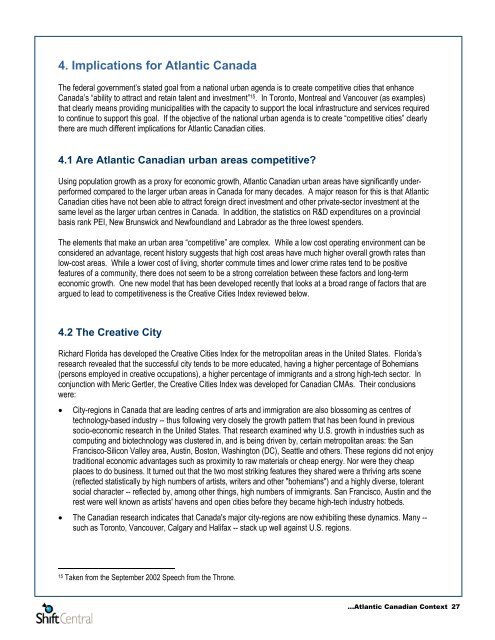Atlantic Canada's Urban Growth Agenda - Greater Halifax Partnership
Atlantic Canada's Urban Growth Agenda - Greater Halifax Partnership
Atlantic Canada's Urban Growth Agenda - Greater Halifax Partnership
You also want an ePaper? Increase the reach of your titles
YUMPU automatically turns print PDFs into web optimized ePapers that Google loves.
4. Implications for <strong>Atlantic</strong> Canada<br />
The federal government’s stated goal from a national urban agenda is to create competitive cities that enhance<br />
Canada’s “ability to attract and retain talent and investment” 15 . In Toronto, Montreal and Vancouver (as examples)<br />
that clearly means providing municipalities with the capacity to support the local infrastructure and services required<br />
to continue to support this goal. If the objective of the national urban agenda is to create “competitive cities” clearly<br />
there are much different implications for <strong>Atlantic</strong> Canadian cities.<br />
4.1 Are <strong>Atlantic</strong> Canadian urban areas competitive<br />
Using population growth as a proxy for economic growth, <strong>Atlantic</strong> Canadian urban areas have significantly underperformed<br />
compared to the larger urban areas in Canada for many decades. A major reason for this is that <strong>Atlantic</strong><br />
Canadian cities have not been able to attract foreign direct investment and other private-sector investment at the<br />
same level as the larger urban centres in Canada. In addition, the statistics on R&D expenditures on a provincial<br />
basis rank PEI, New Brunswick and Newfoundland and Labrador as the three lowest spenders.<br />
The elements that make an urban area “competitive” are complex. While a low cost operating environment can be<br />
considered an advantage, recent history suggests that high cost areas have much higher overall growth rates than<br />
low-cost areas. While a lower cost of living, shorter commute times and lower crime rates tend to be positive<br />
features of a community, there does not seem to be a strong correlation between these factors and long-term<br />
economic growth. One new model that has been developed recently that looks at a broad range of factors that are<br />
argued to lead to competitiveness is the Creative Cities Index reviewed below.<br />
4.2 The Creative City<br />
Richard Florida has developed the Creative Cities Index for the metropolitan areas in the United States. Florida’s<br />
research revealed that the successful city tends to be more educated, having a higher percentage of Bohemians<br />
(persons employed in creative occupations), a higher percentage of immigrants and a strong high-tech sector. In<br />
conjunction with Meric Gertler, the Creative Cities Index was developed for Canadian CMAs. Their conclusions<br />
were:<br />
• City-regions in Canada that are leading centres of arts and immigration are also blossoming as centres of<br />
technology-based industry -- thus following very closely the growth pattern that has been found in previous<br />
socio-economic research in the United States. That research examined why U.S. growth in industries such as<br />
computing and biotechnology was clustered in, and is being driven by, certain metropolitan areas: the San<br />
Francisco-Silicon Valley area, Austin, Boston, Washington (DC), Seattle and others. These regions did not enjoy<br />
traditional economic advantages such as proximity to raw materials or cheap energy. Nor were they cheap<br />
places to do business. It turned out that the two most striking features they shared were a thriving arts scene<br />
(reflected statistically by high numbers of artists, writers and other "bohemians") and a highly diverse, tolerant<br />
social character -- reflected by, among other things, high numbers of immigrants. San Francisco, Austin and the<br />
rest were well known as artists' havens and open cities before they became high-tech industry hotbeds.<br />
• The Canadian research indicates that <strong>Canada's</strong> major city-regions are now exhibiting these dynamics. Many --<br />
such as Toronto, Vancouver, Calgary and <strong>Halifax</strong> -- stack up well against U.S. regions.<br />
15 Taken from the September 2002 Speech from the Throne.<br />
…<strong>Atlantic</strong> Canadian Context 27





